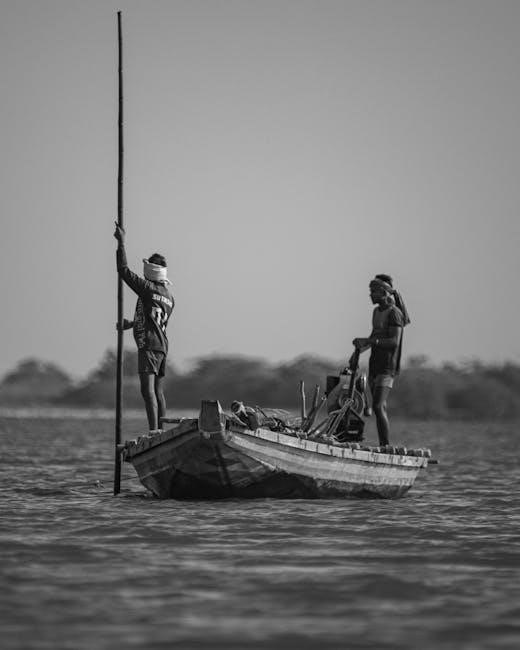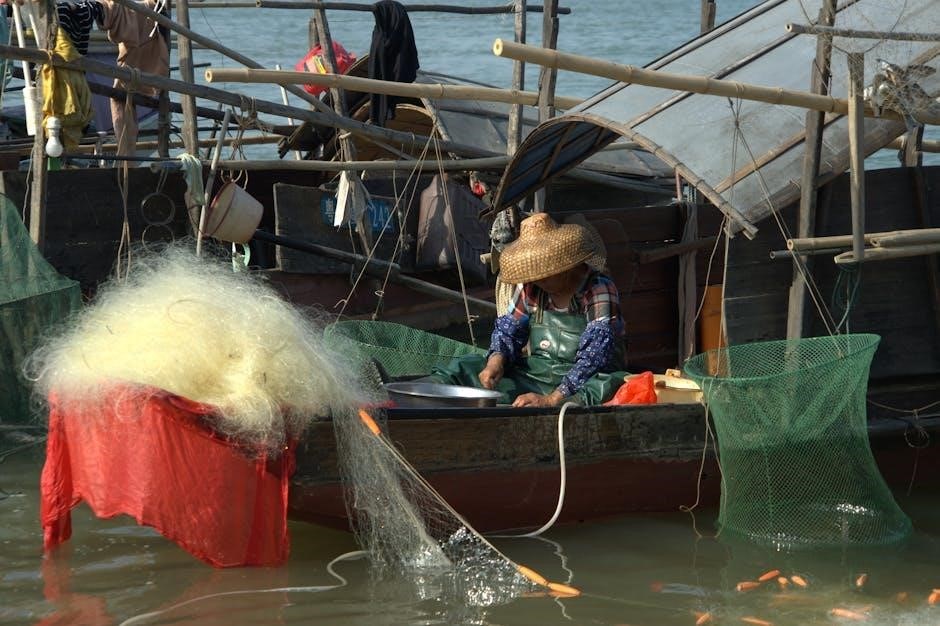Fishing pole size guide helps anglers choose suitable rods for their needs, considering factors like length, power, and action, to enhance their fishing experience with the right equipment and techniques always available online, every day.
Rod Length and Its Importance
Rod length plays a significant role in determining the ease of use and casting distance for anglers, with different lengths suitable for various fishing styles and environments.
The length of a rod can affect the accuracy and distance of casts, as well as the ability to maneuver the rod in tight spaces.
According to online sources, rod lengths can be categorized into small, medium, and large, with each category having its own specific applications and benefits.
Small rods, typically ranging from 4-6 feet, are ideal for fishing in tight spaces, such as streams or when kayaking.
Medium rods, ranging from 6-8 feet, offer a versatile length that can be used for a variety of fish species and fishing techniques.
The importance of rod length lies in its ability to enhance the overall fishing experience, allowing anglers to choose the right rod for their specific needs and fishing style, ultimately leading to a more enjoyable and successful fishing trip.
By considering the length of the rod, anglers can optimize their fishing performance and increase their chances of catching fish.
Rod length is a critical factor in selecting the right fishing rod, and its importance should not be overlooked.
Overall, the length of a rod is a crucial aspect of fishing that can greatly impact the success and enjoyment of a fishing trip.
Classification of Rod Length
The classification of rod length is a crucial aspect of the fishing pole size guide, as it helps anglers determine the most suitable rod for their specific needs.
Rod lengths can be classified into three main categories: small, medium, and large, each with its own unique characteristics and applications.
The small rod, typically ranging from 4-6 feet, is designed for fishing in tight spaces, such as streams, rivers, and lakes with dense vegetation.
The medium rod, ranging from 6-8 feet, is a versatile option that can be used for a variety of fish species and fishing techniques, including trout, bass, and panfish.
The large rod, typically longer than 8 feet, is designed for saltwater fishing, big freshwater fishing, and heavy-duty fishing applications.
By classifying rod lengths into these categories, anglers can easily identify the most suitable rod for their specific fishing needs and environment.
This classification system provides a useful framework for selecting the right rod, and it can help anglers optimize their fishing performance and increase their chances of catching fish.
Overall, the classification of rod length is an essential aspect of the fishing pole size guide.

Understanding Rod Length Categories
Rod length categories are essential for choosing the right fishing rod, with options including small, medium, and large, each suitable for different fishing techniques and environments always available online.
Small Rods for Specific Fishing Needs
Small rods are typically used for specific fishing needs, such as trout, panfish, and kayaking, where a shorter length is beneficial for navigating tight spaces and handling smaller fish.

These rods usually range from 4-6 feet in length and are ideal for fishing in streams, rivers, and small lakes.
The smaller size of these rods allows for more precise casting and control, making them perfect for anglers who need to make accurate casts in tight quarters.
Additionally, small rods are often lighter and more sensitive, allowing anglers to feel even the slightest bites from small fish.
They are also great for beginners, as they are easier to handle and maneuver, making them a great option for those just starting out with fishing.
Overall, small rods are a great choice for anglers who need a rod that can handle specific fishing needs, such as fishing in small areas or targeting small species of fish.
They offer a unique combination of precision, control, and sensitivity that makes them an essential tool for many anglers.
Small rods are a great addition to any angler’s arsenal, and can be used in a variety of fishing situations.
Medium Rods for Versatile Fishing
Medium rods are considered to be the most versatile fishing rods, as they can be used to catch a wide variety of fish species, including bass, trout, panfish, and more.
These rods typically range from 6-8 feet in length and are ideal for fishing in medium-sized lakes, rivers, and streams.
They offer a great balance of power and sensitivity, making them suitable for both beginners and experienced anglers.
Medium rods are also great for fishing with a variety of techniques, including bait fishing, spinning, and trolling.
They are often used for catching fish that require a bit more strength to land, such as bass and trout, but are still sensitive enough to detect smaller bites.
Medium rods are a great all-around choice for anglers who want a rod that can handle a variety of fishing situations.
They are easy to handle and maneuver, making them perfect for fishing in a variety of environments.
Overall, medium rods are a great option for anglers who want a versatile rod that can be used in a variety of fishing situations.
They offer a great combination of power, sensitivity, and versatility, making them a popular choice among anglers.
Large Rods for Heavy-Duty Fishing
Large rods are designed for heavy-duty fishing, typically used for catching larger fish species such as saltwater fish, catfish, and musky.
These rods are usually longer than 8 feet in length and are made with heavier materials to handle the strength and weight of larger fish.
They are often used for bait fishing and trolling, as they provide the necessary power and leverage to cast heavy lures and baits.
Large rods are also used for fishing in deep waters, where the water pressure is greater and the fish are more powerful.
They are designed to handle the stress and strain of fighting larger fish, and are often used by experienced anglers who target specific species.
The larger size of these rods also provides a greater casting distance, allowing anglers to reach farther out into the water.
Large rods are a necessity for heavy-duty fishing, as they provide the power and strength needed to land larger fish.
They are a specialized tool, designed for specific fishing applications, and are an essential part of any serious angler’s arsenal.
Overall, large rods are a crucial component of heavy-duty fishing, providing the necessary power and strength to catch larger fish species.

Power and Action of Fishing Rods
Rods have unique power and action characteristics affecting fishing performance and results always online every day with specific details available now everywhere instantly.
Rod Power and Its Significance
Rod power refers to the amount of force required to bend the rod, which is a critical factor in determining its overall performance. The power of a rod is typically categorized as ultra-light, light, medium, medium-heavy, or heavy, with each category suited for specific types of fishing and species of fish. A rod with higher power is more suitable for catching larger fish, as it can withstand the strength and fight of the fish. On the other hand, a rod with lower power is more suitable for catching smaller fish, as it provides a more sensitive and responsive feel. The significance of rod power lies in its ability to determine the overall fishing experience, including the ease of casting, the sensitivity of the rod, and the ability to land fish. By choosing a rod with the appropriate power, anglers can enhance their chances of success and enjoy a more rewarding fishing experience. Rod power is a key consideration for anglers of all levels, from beginners to experienced professionals.
Rod Speed or Action Explained
Rod speed or action refers to the way a rod bends when it is subjected to pressure, such as when a fish bites or when casting. The action of a rod can be classified as fast, medium, or slow, depending on the degree of bending. A fast action rod bends only at the tip, while a slow action rod bends throughout its length. The action of a rod affects its sensitivity, casting distance, and ability to set hooks. A fast action rod is more sensitive and provides a faster hook set, making it suitable for fishing techniques that require quick reflexes. On the other hand, a slow action rod provides a more gradual hook set and is often used for fishing techniques that require a more subtle presentation. Understanding rod speed or action is essential for choosing the right rod for a specific fishing application. By considering the action of a rod, anglers can optimize their fishing performance and increase their chances of success. Rod action is a critical factor in determining the overall performance of a fishing rod.
Importance of Rod Power and Action
The importance of rod power and action lies in their impact on the overall fishing experience. Rod power and action determine the rod’s ability to handle different types of fish, bait, and fishing techniques. A rod with the right power and action can help anglers detect bites, set hooks, and land fish effectively. The combination of rod power and action also affects the rod’s sensitivity, casting distance, and ability to handle heavy loads. Understanding the importance of rod power and action enables anglers to choose the right rod for their specific fishing needs, increasing their chances of success and enhancing their overall fishing experience. By considering the interplay between rod power and action, anglers can optimize their fishing gear and techniques to suit their target species, fishing style, and environment. This knowledge is essential for anglers to make informed decisions when selecting a fishing rod, and to get the most out of their fishing trips. Effective rod selection can make a significant difference in the outcome of a fishing trip.

Choosing the Right Rod for Fishing Needs
Anglers must consider their specific fishing needs and techniques when selecting a rod, using online resources to find the perfect match always available every day with ease and convenience online.
Matching Rod Action to Fishing Style
To effectively match rod action to fishing style, anglers should consider the type of fishing they will be doing and the species of fish they are targeting. For example, a fast action rod is well-suited for fishing styles that require quick hooksets and precise control, such as jigging or pitching. On the other hand, a slow action rod is better suited for fishing styles that require a more subtle presentation, such as live baiting or trolling. By matching the rod action to the fishing style, anglers can increase their chances of success and enjoy a more enjoyable fishing experience. The key is to find a rod that balances sensitivity and power, allowing the angler to feel bites and set hooks effectively. With the right rod action, anglers can tailor their fishing technique to the specific needs of their target species, leading to more productive and enjoyable fishing trips. This requires some experimentation and practice to get it just right.
